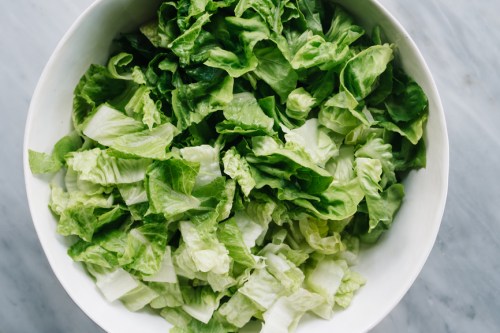3 Reasons Why You Should Rewash That Pre-Washed Bag of Lettuce, According to Food Scientists
Here are three reasons why you should wash pre-washed lettuce before eating, according to two food scientists.

Okay, without raising too much cause for concern, let it be known that seeing the label “Pre-washed” on a bag of lettuce might not really mean much. Of course, before you panic, we know that there are foods (like Jelly Belly’s mystery-flavored jelly beans… “Not the booger one again!“) that cause real trust issues—and that pre-washed lettuce luckily doesn’t fall into this category. What we do know, however, is that pre-washed bagged greens aren’t necessarily quite as ready-to-eat as we like to assume. Luckily, it isn’t a huge cause for concern.
Experts in This Article
Director and Professor of in the Department of Food Science &
UK-based food scientist and CEO of Nali Consulting
That being said, food scientists do say that there are a few reasons why you might still want to rewash your bagged lettuce to reduce your risk of foodborne illness. And although it might seem like overkill—especially when the packaging says your salad has been “Triple-washed!”—they advise it’s best to err on the side of caution. So, before you make your favorite homemade salad recipe, check out these three reasons why you should *rewash* pre-washed greens whenever possible.
3 reasons why you should rewash pre-washed bags of lettuce or greens, according to food scientists
1. Prewashing at food packaging facilities isn’t 100 percent effective
According to Francisco Diez-Gonzalez, PhD, professor and director of the Center of Food Safety at the University of Georgia, rewashing pre-washed greens isn’t totally imperative, but it’s still going to be worth it. “It’s not entirely necessary to wash them, but if the consumer has time, it is advisable to do it. Remember that even the washing done before packing is not 100 percent effective, so an additional washing by the consumer may help to reduce the risk even further,” Dr. Diez-Gonzalez says.
2. Produce is at high risk for contamination that can cause foodborne illnesses
Natalie Alibrandi, a London-based food scientist and CEO of Nali Consulting, also agrees that you should be rewashing pre-washed greens. Why? Because they’re extremely susceptible to contamination. “Pre-washed lettuce may seem like the pick of choice when you are rushed and need something convenient; however, I would think twice before grabbing that bag. Although pre-washed lettuce is pre-washed—and can be up to three times—there’s still a risk for microorganisms like salmonella, E.coli, and listeria to make their way through,” Alibrandi says.
3. You can better control how clean the washing environment is at home
As Dr. Diez-Gonzalez alludes to, you can run into contamination issues even before the lettuce makes its way to your local grocery store. This is yet another reason why Alibrandi says it’s better to wash your greens at home. “You have control over the environment at home, which means you can take extra precautions to avoid cross-contamination,” she says. For instance, make sure that your sink and colander or salad-spinner are completely clean before you wash your salad, and that you’re using fresh, potable water to rinse the greens. It’s also imperative to avoid letting your raw greens get into contact with other perishable foods like raw meat, seafood, or dairy.
The best way to wash lettuce or greens
Alibrandi suggests a five-part process (it’s easy, we promise) for cleaning lettuce that she swears by—and it involves skipping the pre-washed bagged lettuce altogether. “A better option that is fresher, safer, and more affordable is grabbing a head of lettuce whole and cleaning it in a salad spinner.” To do so, she says to soak the lettuce for about 10 minutes first to naturally allow the dirt to settle to the bottom, then wash through in the sink and spin. “Pick through the lettuce to find any bad pieces, and dry thoroughly before eating,” Alibrandi says.
As Alibrandi mentions, using a whole head of lettuce versus a precut one might be the better choice. This, she says, is because it has less exposure to contamination as it’s being handled less at food processing facilities. When using a whole head of lettuce, however, the FDA recommends also removing the outermost leaves of a head of lettuce or cabbage (that are most exposed to contaminants).
Also, keep in mind that it’s unnecessary to use soaps or sprays to wash produce—cool, clean running water will do the trick just fine. Need more produce-cleaning tips and tricks? You can also follow the FDA’s quick and easy seven-step guide to cleaning fruits and vegetables.
What to do with all of your super clean lettuce? Make this vegan kale Caesar salad:
Sign Up for Our Daily Newsletter
Get all the latest in wellness, trends, food, fitness, beauty, and more delivered right to your inbox.
Got it, you've been added to our email list.










